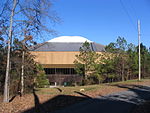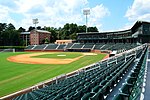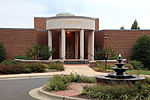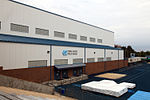The Dean E. Smith Student Activities Center (commonly known as the Dean Smith Center, Smith Center, or the Dean Dome) is a multi-purpose arena in Chapel Hill, North Carolina, used primarily as the home for the University of North Carolina at Chapel Hill Tar Heels men's basketball team. The university began to inquire about building a standalone arena for the men's basketball team beginning in the mid-1970s, but due to an ongoing university wide investigation, the fundraiser halted until its conclusion. In June 1980, the fundraising began with a goal of at least $30 million and a target completion date for the building of December 1984. It was initially planned to be called the Student Activities Center; however, after its announcement it began to be referred to as The Dean Dome and it was speculated it would be named for then coach Dean Smith. The fundraising concluded in August 1984 with over $33 million raised, but construction would not be finished until 1986. The day before the opening game on January 18, 1986, against the Duke Blue Devils, the building was officially announced to be named the Dean E. Smith Student Activities Center, while a formal dedication happen later in September. In 2018, the hardwood floor of the Smith Center was named for then coach Roy Williams.
Land was cleared in a wooded ravine on the southern part of campus and necessitated 20,000 cubic yards (15,000 m3) of rock to be dynamited out. The building is 300,000 square feet (28,000 m2) and build on 8 acres (3.2 ha) and contains three levels. There are two levels for seating, an upper and lower level, from which the furthest viewing distance is 675 feet (206 m). The Dean Dome has been renovated several times since its opening which has included the likes of new video boards, video ribbon along the upper level edge, seats, lighting, and sound. In addition, the locker rooms and office space have all been upgraded. Throughout the years the capacity has been adjusted through the removal of box seating for traditional seating and the addition of a standing student section behind one of the goals. The future of the arena is questioned due to a variety of issues stemming from a narrow concourse, limited storage, and a desire to have premium seating to earn more revenue. The issue is further complicated by the fact the Smith Center was privately funded and the seats paid for by the initial donors carry two full generations, which limits any possible renovation, but could be circumvented by building a new arena.
Through the 2021–22 season, the Tar Heels have played 37 seasons in the Dean Smith Center and have earned over 450 victories and under 100 losses. Despite their home success, the crowd has often been criticized for being dull and un–involved, which has been credited to the seating arrangement created by the above–mentioned donors which has limited the ability of the students to use the lower level and create noise. In addition to basketball, the venue has been used to host several concerts, graduations, sporting events, and a speech by Barack Obama when campaigning for the Democratic presidential nomination.












